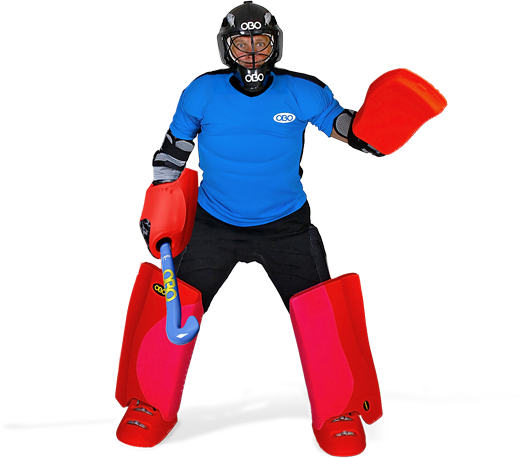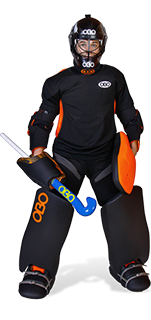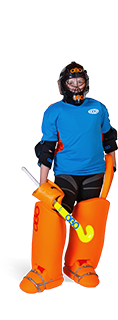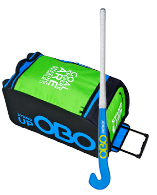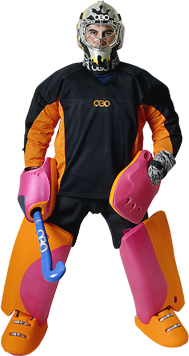KEEPERS RESOURCES

Raising your gloves on short corners
If you watch most of the high level leagues, you will notice that the majority of goalkeepers have their gloves high up on the short corner. Just looking at the Euro Hockey League or the Hoofdklasse, for example, on short corners you will pretty much see all of the goalkeepers with their hands up high when getting set in the stance; expecting to deal with a high drag flick. The reason is simple: by having their gloves up higher, it is easier to move in for the save (even if they dive high into the save, since the gloves are already there and don’t need to be brought up). Rather than being played by the situation, they pro-actively change their stance to help their shot stopping abilities. With their hands already up, they give themselves an improved chance of making the save.
Have you ever watched a goalkeeper make a save against a well struck hit bringing their glove up , or tried yourself to stop a fast ball aimed at the top of goal with your hands low? Ball speeds and accuracy mean it is not possible. Do you think you’d be able to stop one of Taeka Taekema’s or Sohail Abbas’s awesome drag flicks powered into the roof of the net with your gloves starting from a low position?! It’s simply not logically possible, so you therefore need to change technique to increase your save capabilities; with raised gloves, you have an better chance.
When facing drag flicks on short corners, at the higher levels of the game, it is important to raise your gloves if you want to be able to make the save from a standing position. With your gloves raised, you have less of a distance to move, to get them up to block; as a result, there is a greater percentage chance of actually stopping the ball from ending up in the back of the net. If you intend to make the save from a standing position, then you will need to have the gloves to be able to reach the ball, otherwise you will need to get aerial.
Low gloves giving away shooting space
If you normally play with your gloves at a low height within your ready stance, then you are going to get ‘burned’ and made to look silly if you still play with them low, when facing high drag flicks from a standing position. Even if you jump or dive into the save, it will still take time to move them up; time you do not have when playing against highly skilled opponents. With accurate power and placement, a well placed drag flick into the top corner of the goal, or high to the sides, away from your reach, will not be stoppable. You simply cannot get to it quickly enough. If you are playing against a team with drag flickers that have a tendency to exploit such areas, then you should not expect to be able to make the save, if you a making the wrong technique selection.
The problem when you have your gloves around your hips or body, which is useful when facing shots around that area, but becomes useless when you are faced with raised flicks or shots, as you cannot reach the high shot in time, with the speed of it. Swinging the arm up in vain will not be of any use: you won’t be able to get the glove up in time, whereas having the gloves already in position means that you are already there for the save.
As these action shots show, it is near impossible to try and save a high flick with a low glove position:
The following video is a good example of failed technique with the goalkeeper trying to save a high drag flick from a position with their gloves lowered (playing time around 30 seconds in).
Raising your gloves
Most goalkeepers raise their gloves to shoulder height (as taught in Europe), giving them enough height to push up into a high save. In Australia, goalkeepers are encouraged to have their gloves around head height. Both arms are spread out at an equal distance, outside the body, in a symmetrical V shape. This way you cover more of the goal, as well allowing you to use the gloves independently; pushing the appropriate hand out separately to block. By raising your gloves you are making life easier for yourself. Although people think that playing a reflex style means you need to and then react immediately by moving the glove up, you can actually use your reflexes to move into the save with the speed of the ball, as they are already in position; gaining a slight advantage over the powerful drag flick coming at you with speed.
Technique
When making an upright save maintaining balance remains important. If you do not balance properly, you will not be able to reach into the save, or balance it successfully (falling back/losing balance in the process). You need to move into the save, pushing your body from the head (to maintain balance) to drive into the motion; bringing your glove into contact by pushing from the arm to properly connect with the incoming flick. If you find that it is not possible to reach into the save from a standing ready stance, then you will need to get aerial and high dive into the save.
By taking a look when setting up for the short corner, you can then alter your stance as you get ready within the goal. Knowing that you will be facing a drag flick (by analysing the shooter’s body position) you can then raise your gloves to help in your save making. If you play against the time regularly in the season, or have played them previously, then you and your team should know their tendencies, which will help in your decision making. However, be aware of changes in routine, which will be brought in if you are successfully stopping the opposing team’s chances, and can catch you off guard if you are not aware of the change.
If you end up facing a lower flick than expected (around body/hip height), then you can bring your gloves down to block. Gravity is on your side and it is actually quicker to bring your hands down, than to try to get them up, so it should not be too difficult to make the save if you force your glove down quickly to cover.
Rule of thumb
The rule of thumb is whether or not you will be facing a drag flick. There would be no point using raised gloves when facing a straight strike, as your priority is to get down against the shot to cover the percentages. You can tell by the shooter’s hand positioning on their stick whether or not they are going to drag flick (their hands will be open, spread apart, whereas closed hands at the top of the stick mean a strike). If you know that the opposing shooter likes to shoot high, then it becomes easier to know when to use the raised glove position.
Comments
Leave Your Comments Below















